In the middle of England’s former coal country, a dozen massive stately homes cluster, all of them impressive and worth a visit.
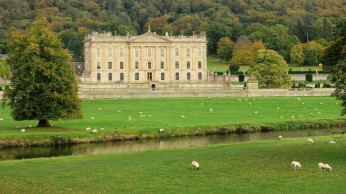
Chatsworth
Travelling north on England’s major M1 motorway, admiring the rolling hills and pastures on each side of the highway, one could be forgiven for bypassing a big slice of the country’s heritage. Within a short drive of the M1 are several massive stately homes, almost all of them worth a visit. You can visit 10 of them which huddle in the short distance between exits 29 and 30, where the counties of Derbyshire, Nottinghamshire and South Yorkshire meet. Once this area was riddled with coal mines, and ownership of the mines and industry created the enormous wealth that built these homes. Now the coal mines are all closed, and the heavy industry is gone too, so the land has returned to its former green and pleasant self.
The glorious and now gilded pile of Chatsworth is the best of the bunch. It’s one of the most luxurious residences in England, still privately owned by the Cavendish family, beautifully sited on a vast estate and soon to open again for the season. Guided tours of the house take in about 30 of the most spectacular rooms, filled with more palatial furniture, art and tchotchkes than you can imagine, or you can wander around at your own pace. The gardens are worth a tour of their own with the famous fountain and water cascade dominant. There are always side activities and art shows in the house and grounds. The gift shop is excellent. The cafes are often crowded. A few miles away the Chatsworth Farm Shop provides the best of local fare and houses a cafeteria style restaurant. The Duke also owns two or three pubs with rooms and a very good hotel on the estate, if you decide to make this the centre of a tour of Derbyshire.
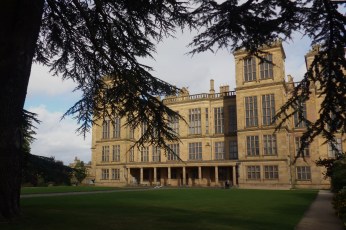
Hardwick Hall
It was once made famous with the little rhyme “Hardwick Hall, more window than wall.” To show off her fabulous wealth, Bess of Hardwick, the richest woman in England and chum of Elizabeth I, made the ceilings of each floor taller than the one below and emblazoned them with expensive glass. The state rooms on the top floor proclaimed her eminence in society. They are filled with Tudor treasures and a throne like receiving room. Amazingly, the house remains much as she left it. After she died in 1608 the Cavendish family lived principally at Chatsworth, and the house escaped the depredations of modernization. The restaurant is quite good.
The adjacent Old Hall is just a shell, left as a ruin by Bess when she decamped to her splendid new quarters, but still worth a wander around.
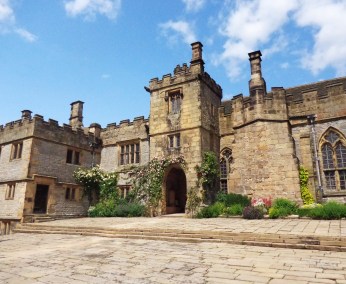
Haddon Hall
You’d be right for thinking Haddon Hall looks like a film set. It’s been seen in many movies, including The Princess Bride. The frontage still shows the original fortifications. The same family has occupied the house continuously since the mid-1100s, although it has seen many renovations. Lord Edward Manners, younger brother of the 11th Duke of Rutland, lives there now, but most of the house is open to the public. The ancient kitchens and the impressive long gallery are well worth seeing. The gardens are lovely. There’s a small café on site.
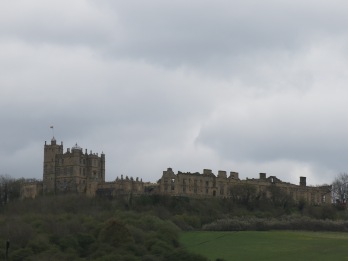
Bolsover Castle
The imposing silhouette of Bolsover Castle can be seen from the motorway. On the site of a long abandoned 11th century Norman castle, one of the Cavendishes inherited an exquisite miniature castle from his father in 1617, built as a playboy’s escape. He added a very grand range of state rooms on the neighbouring escarpment and a large Riding House, where he entertained his guests with displays of horsemanship. However, after he died, his son barely visited and the state apartments fell into ruin. By the turn of the last century, local mining and subsidence had put the Little Castle in danger of collapse. However, finally English Heritage got hold of the place and has recently done some worthwhile restorations. The Wall Walk and the gardens are dramatic and the remains of the Terrace Range are impressive. The Little Castle has some well set out rooms with reproduction furniture, so you can sit where you want and touch everything. There’s free parking and a café. Equestrian shows and period re-enactments entertain all summer.
Renishaw Hall includes gardens and country walks down to the lake. The house has been privately owned by the eccentric Sitwell family of artists and writers for about 400 years. The current owner, Alexandra Sitwell, allows guided tours on Fridays and some weekends. The extraordinary Italianate gardens were laid out in the late 19th Century by her brilliant great-grandfather. There’s an excellent café.
Sutton Scarsdale Hall offers free entry while extensive renovations continue, so only the exterior and gardens can be viewed. The imposing shell of a huge Georgian mansion completed in 1729, with an immense columned exterior, has been roofless since 1919. Most of the interiors were sold off, dismantled, and exported to America in 1919, where some bits were used for film sets.
With reputedly the widest frontage in Europe, Wentworth Woodhouse is another huge home which has seen better times. Coal mines came within 16 feet of the backdoor and subsidence problems continue. However, it has recently been taken over by a trust, who have massive renovation plans. Meanwhile guided tours are worthwhile, and essential to avoid getting lost in the 365 rooms. Little of the original furniture remains, but one of the former owners saved much of the contents, and has apparently offered them back to the estate.
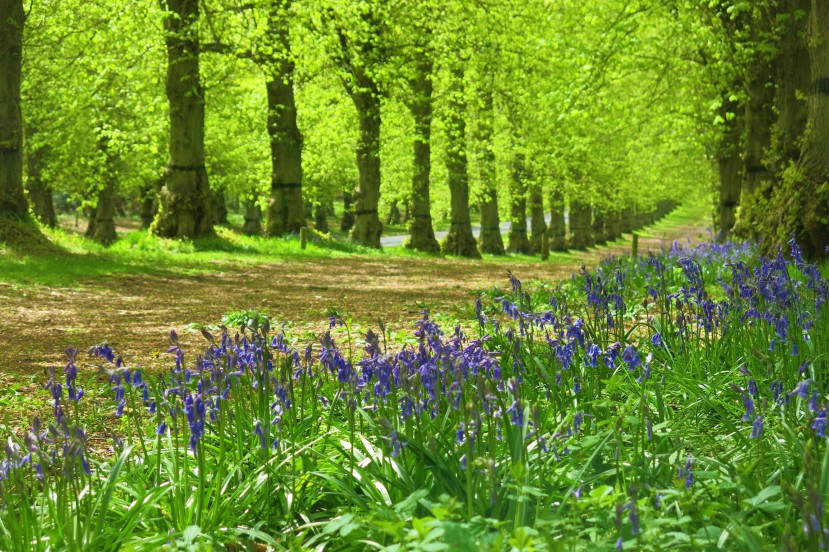
Lime Tree Avenue
The Dukeries are four contiguous ducal estates, which managed to acquire most of Sherwood Forest at the time of the dissolution of the monasteries. There’s a lot of history attached to these old properties where not all the grand palaces survive. Clumber House was the principal seat of the Dukes of Newcastle, until it was demolished in the 1930s. Thoresby Hall was the principal seat of the Dukes of Kingston and later six Earls Manvers, until it was sold and is now used as a hotel. Welbeck Abbey was principal seat of the Dukes of Newcastle and later the Dukes of Portland, whose descendants have returned after a long hiatus. Worksop Manor was the seat of the Earl of Shrewsbury, then the Dukes of Norfolk, until it was sold to the Dukes of Newcastle, who demolished the main wing. The remaining, very large house is still in private hands.
The best part of Clumber Park is getting there down the lengthy Lime Tree Avenue, bordered by 1,296 common limes planted in 1840. After a fire in 1912, the house was abandoned and finally demolished in 1938. Only the footprint remains on the lawns that lead down to the ornamental lake. The visitor centre is in the old stable block with a cafeteria style restaurant. The four-acre walled kitchen garden is worth a peek. Among other curiosities are 101 varieties of local apples and 121 varieties of edible rhubarb.
The original lands on which Thoresby Hall was built were acquired about 1633, but none of that house survive. The current pile was erected in 1874. Since 2000 it has been a hotel, spa and conference centre and the Great Hall is an excellent spot for afternoon tea.
Welbeck Abbey, also has links to Bess of Hardwick, dating back to the time of Henry VIII. The huge and palatial property was added to by many generations of Cavendishes, until it became the seat of the Duke of Portland. The younger sister of the last unmarried heir married an Italian prince, and it is her son, William Parente, who lives there now with his family. The main house is only open for tours in August, but for the rest of the year the farm shop is a good bet for excellent local foods. The generous family shows off thousands of treasures from the house in the Portland Collection gallery, which is free. The house is simply vast, but a huge underground ballroom and a tunnel network which allowed the 5th Duke to cross his estate by carriage entirely underground, are off limits.
The final ducal palace, which the public can’t visit, is Worksop Manor. For a while it served as Mary Queen of Scots prison. After a fire in 1761, a vast new house was started, which would have been one of the largest houses in England, had it been completed. After a death, the estate became neglected. It was later sold to the owner of Clumber, next door, who demolished the main wing with gunpowder and added the land to his own properties. Later the surviving parts of the house were formed into a new mansion and, along with part of the estate, eventually acquired by the High Sheriff of Nottinghamshire, a distinguished breeder of thoroughbreds, whose descendants live there still, operating the Worksop Manor Stud.
Depending on the season, the opening hours and the popularity of these venues will vary widely, so it is best to check and book your tickets in advance online.
Details and how to get there:
1. Chatsworth – M1 Exit 29, 14.3 miles 37 minutes drive. Chatsworth is a huge and magnificent stately home, built in 1549. Ancestral home of Peregrine and Amanda, Duke and Duchess of Devonshire, who live there. Most of the state rooms are open to the public. Restaurants and cafes on site, or visit the separate Chatsworth Farm Shop and Restaurant. Gardens and house open from March to October and December until the Christmas Holidays. Website: www.chatsworth.org
2. Hardwick Hall – M1 Exit 29, 3.1 miles 8 mins. Magnificent Tudor mansion, build by Bess of Hardwick in 1590. Estate and restaurant are open year round. Operated by the National Trust. Website: www.nationaltrust.org.uk/hardwick-hall
3. Hardwick Old Hall, adjacent to Hardwick Hall. Just the shell of Bess’s original house remains. Operated by English Heritage. Website: www.english-heritage.org.uk/visit/places/hardwick-old-hall
4. Haddon Hall – M1 Exit 29, 16.5 miles 34 mins. Fully functional fortified medieval manor house, built in 1100s. Film location for The Princess Bride, Gunpowder and many others. Privately owned by Lord Edward Manners, but most of the state rooms are open to the public daily between March and September, and December until Christmas Eve, long weekends in October. Website: www.haddonhall.co.uk
5. Bolsover Castle – M1 Exit 29A, 3.2 miles 7 mins. Only the Little Castle and Riding School remain of the original medieval fortress. Operated by English Heritage. Website: www.english-heritage.org.uk/visit/places/bolsover-castle
6. Renishaw Hall and Gardens – M1 Exit 30, 2.6 miles 6 mins. Gardens only open to the public, guided tours of the house on Fridays only, August weekends. Privately owned by the Sitwell family. Website: www.renishaw-hall.co.uk
7. Sutton Scarsdale Hall – M1 Exit 29, 2.7 miles 6 mins. Ruined, major conservation work ongoing, so exterior visits only. Operated by English Heritage. Website: www.english-heritage.org.uk/visit/places/sutton-scarsdale-hall
8. Wentworth Woodhouse – M1 Exit 35, 3.4 miles 9 mins. The stately home with the longest frontage in Europe at more than 600 feet. Bought by the Wentworth Woodhouse Preservation Trust in March 2017. Film location for the TV series Victoria.
Guided tours only while renovations continue. Website: www.wentworthwoodhouse.co.uk
The Dukeries near Worksop: Four contiguous ducal estates managed to acquire most of Sherwood Forest at the time of the dissolution of the monasteries. The estates remain, along with some of their stately homes, and the forest is being reacquired for public use.
9. Clumber Park, Nottinghamshire – M1 Exit 30, 11.5 miles 21 mins. Gardens only remain, exhibits in the stable block and walled garden, café and restaurant. Main attraction: Lime Tree Avenue. Operated by National Trust. Website: www.nationaltrust.org.uk/clumber-park
10. Thoresby Hall – M1 Exit 30, 13.8 miles 24 mins. Now a 200–bed hotel, conference centre and spa. Website: www.warnerleisurehotels.co.uk/hotels/thoresby-hall-hotel
11. Welbeck Abbey – M1 Exit 29A, 9.9 miles 17 mins. Farm shop, café and Portland Collection gallery open daily. Privately owned by the Parente family. Huge and elegant main house: state rooms open for guided tours in August only. Website: www.welbeck.co.uk
12. Worksop Manor – M1 Exit 30, 7.2 miles 13 mins. Only the lodge remains as a private home, not open to the public.
Sherwood Forest, Nottinghamshire –M1 Exit 29, 12.8 miles 32 mins. Free entry, parking fee, restaurant. Main attraction: The Major Oak is a half–mile walk along well–kept trail from the visitor centre. Website: www.nottinghamshire.gov.uk/planning-and-environment/country-parks/sherwood-forest
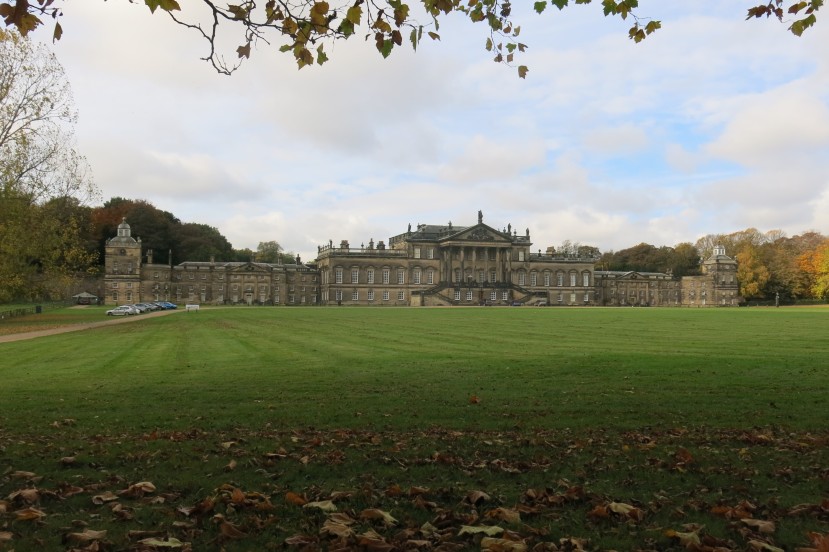
Featured image: Wentworth Woodhouse
Categories: Travel

Nigel, you should submit this to the Guardian or the Globe for their travel sections
LikeLike
Sadly, this has been thought not “a good fit” for the old mop and pail! We keep trying …
LikeLike
Good grief, you’ve done more than most from your part of the world in visiting our little island! Most get only to London, Stratford and Edinburgh!
LikeLike